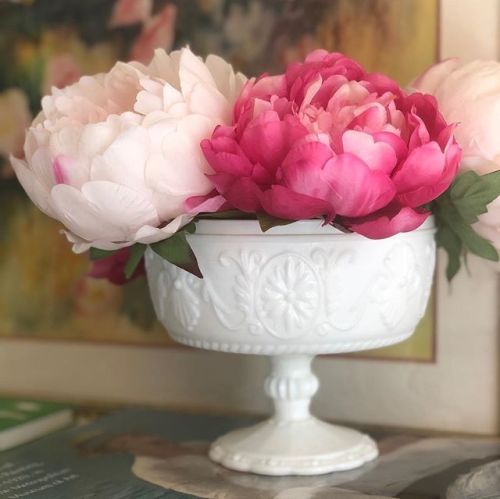 An opaque glass, forerunner to the milk glass we know today, actually originated in 16th century Venice. This glass was available in a rainbow of hues from pink to yellow, blue to brown, and of course, white.
An opaque glass, forerunner to the milk glass we know today, actually originated in 16th century Venice. This glass was available in a rainbow of hues from pink to yellow, blue to brown, and of course, white.
Later, the white glass became wildly popular during the Victorian era (this is defined as the period of England’s Queen Victoria’s reign, from 1837 until 1901). And, it was during this time that the opaque glass became commonly known as milk glass.
Although production slowed down considerably after the turn of the century, milk glass was still made during the 1920s through 1940s. It then experienced a massive resurgence after World War II. And, the glass from the 1950s and 1960s (from familiar companies such as Anchor Hocking, Fenton, and Westmoreland) is most likely what you’ve inherited from your mother or great aunt!
How is milk glass produced?
Milk glass, unlike clear glass, gets its opacity through additives such as bone ash, feldspar, tin dioxide, arsenic or antimony. Some older pieces from the late 1800s also may contain lead. (To identify, give the piece a good rap with your knuckle. And, if it contains lead, it will ring like a bell.)
As manufacturing techniques have evolved, the look of the glass has changed, as well. For example, 19th century glass tends to be extremely opaque and is less shiny.
Milk glass dating from the early 20th century through the 1950’s has an iridescent look to it. This is because, prior to 1960, it was iridized, producing a subtle rainbow effect. (According to experts, holding a piece up in natural light will indicate a rainbow effect on the rim of older pieces sometimes called the “Ring of Fire.”)

Popular shapes for milk glass
The vast number of companies which have produced milk glass, combined with the longevity of its popularity, mean that it is available in hundreds of shapes and patterns for myriad uses. These include:
- Banana stands (from the Victorian period)
- Bowls
- Cake stands and compotes
- Candlesticks
- Covered dishes
- Drinking glasses or tumblers
- Novelty items
- Oil and vinegar cruets
- Pitchers
- Punch bowls (these were popular in the 1960s)
- Serving pieces
- Vases and bud vases
Of special note, milk glass dinnerware was never produced. All of the plates you may discovered were originally intended as decorative décor or serving pieces.

Identification, age and patterns
Milk glass is available in an almost bewildering array of designs. A few of the more easily found patterns include hobnail, floral and fruit.
Older designs include dolphin motifs (which actually look more like fish), as well as other types of animals and birds galore.
The rarest include stars and possibly even a president’s likeness (such as Washington, Garfield or Lincoln). During the Spanish-American War, there were even covered dishes shaped like ships or busts of Admiral Dewey. And, the “Holy Grail” of milk glass collecting are plates that launched the 1908 presidential campaigns of both William Howard Taft and William Jennings Bryan.
Designs can sometimes help with the identification process, because unfortunately, many of the pieces often do not include company markings on the bottom. (For example, hobnail, which happens to be my personal favorite, wasn’t actually introduced until the 1960’s.)


Popular manufacturers
The largest manufacturers include:
- Atterbury & Company
- Bryce Brothers
- Federal
- Fenton
- Fire-King/Anchor Hocking
- Gillinder & Sons
- Hazel Atlas
- Imperial
- Indiana
- McKee
- New England Glass Company
- Westmoreland Glass Company
Where to find milk glass?
Because milk glass has been in practically continuous production for over 100 years, finding it is easy. Manufacturers were highly concentrated in Eastern Pennsylvania, so if you live on the East Coast, a trip to your local antique mall or flea market will yield dozens (if not hundreds!) of options.
Of course, even if you’re from the South, Mid-West or Western US, popular patterns are still quite easy to find. But, rather than peruse antique shops, I prefer to scour estate sales and local thrift shops in search of truly unique pieces. These can often be had for as little as 25 cents! (Click here for my top thrift shopping tips.)
Want to learn more about milkglass?
These, and many more collector’s books and guides, are available on Amazon:
- The Big Book of Fenton Milk Glass, 1940-1985, by John Walk
- Milk Glass: Imperial Glass Corporation Plus Opaque, Slag & More, by Myrna Garrison
- Collectors Encyclopedia Of Milk Glass Identification/Values, by Betty Newbound and Bill Newbound
- The Milk Glass Book, by Frank Chiarenza
 While you’re here, please take some time to enter our most recent fashion, beauty and style giveaways. And, if you enjoyed this milkglass post, please visit Fabulous Interiors for more inspiration.
While you’re here, please take some time to enter our most recent fashion, beauty and style giveaways. And, if you enjoyed this milkglass post, please visit Fabulous Interiors for more inspiration.
WANT A PRODUCT REVIEW? HERE’S HOW: If you have a fashion, beauty or style product line or service and want an honest evaluation, or if you would like to create a giveaway event, please contact us.
DISCLAIMER: No financial compensation was received in exchange for this milkglass post. Regardless, I only recommend products or services that I believe will be beneficial for my readers.
Susan Said… WHAT?! is your guide to style for the way you live and was named one of the Top 50 Beauty Blogs in the World by RebateZone. You’ll find everything from fashion, jewelry, and beauty, to gorgeous gardens, stunning interiors and DIY projects, plus the latest ideas events of all kinds.